How to Do Content Research for Blog Posts that Convert

This is a post for anyone new to content marketing and anyone looking to boost their skills in creating compelling content that performs well on whatever metrics you care most about – SEO, social engagement, thought leadership, sales enablement, etc.
Key to any of those objectives is knowing how to put together a sturdy argument, and that requires research. While that research can take many forms, the fastest and least expensive way to do it is by compiling existing third-party sources rather than conducting original independent research (which also has a place in many content marketing programs, and which I’ll address in section 6!).
Here, I’ll lay out eight of my time-tested strategies for doing this content research well so you can build structurally sound blog posts that convert.
1: Be Curious and Pay Attention
Some of my best research happens when I’m not doing research at all – when I’m reading books, listening to the news, scrolling through Twitter, or having conversations that aren’t related to work or content or blogs.
That’s because these activities expand my world in unplanned ways, which inevitably leads me to insights and information I wouldn’t have otherwise come across.
Put differently: looking for something you want is a learnable skill. It’s essential to doing content research, and I’ll spend most of this post offering strategies for how to do it well. But learning to pay attention when you’re not actively researching will yield a much richer and more diverse world of information you can draw from when you’re creating content.
If you don’t already, get in the habit of…
- Reading books and articles unrelated to your job.
- Listening to, watching, or reading the news.
- Curating a Twitter feed of interesting people who share interesting ideas. Read their threads and the resources they share.
- Talking to people.
- Going to events (or virtual events) outside of your comfort zone.
- Sharing what you find.
Don’t do these things with the goal of DISCOVERING INSIGHTS or FINDING STATISTICS, because if you do, you’ll have less fun, which means you probably won’t keep doing them, which would defeat the whole point.
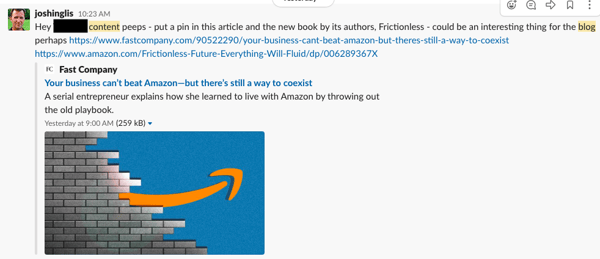 The Propllr team shares potentially useful information in Slack
The Propllr team shares potentially useful information in Slack
Over time, you’ll find that you start to see connections among things you never realized were linked, you understand complex ideas, you’re aware of people and places you weren’t a few years ago, and you have a much easier time building editorial calendars because of it.
2: Get Sleuthy
Research is for things that can be found fairly easily. Sleuthing is for things that are more hidden.
While you’re being curious as a kind of background content research practice, you’ll also have to find information tied to specific projects with hard deadlines. To find it in a tight timeframe, you have to put on your sleuthing hat.
I cannot emphasize enough how important sleuthing is to the content research process. I think of sleuthing as a kind of high-level research in that it involves an extra layer of tenacity and diligence.
As far as I can tell, effective sleuthing comes down to doing these three things:
First: Asking simple questions
Sometimes I want a really obscure number – say, whether mobile device management (MDM) solutions can save organizations money – and if so, how much. Even if I doubt there’s much research on the matter, I start with a direct, simple query.
Because you know what? Sometimes that number is out there, and I save myself a lot of time by checking. Even when it’s not, I usually discover something that’s useful to me, whether it’s insight about the industry or a sense of what is being measured.
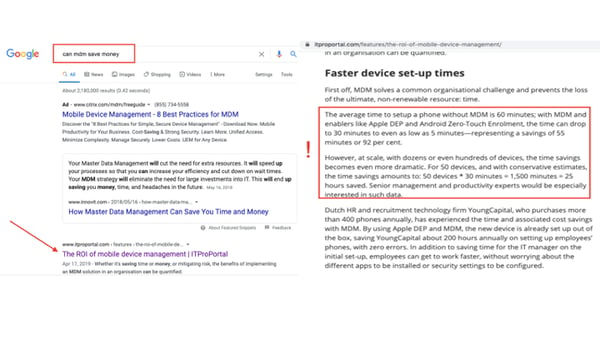 Look! A concrete answer!
Look! A concrete answer!
Second: Refining your questions
This can become an art. Once you determine the straightforward answer you hoped for isn’t available, it’s time to ask your question in different ways.
Here’s an example from a time I was trying to track down a stat that a client had mentioned in an offhand way: that about 80 percent of homeowners refinance their mortgages with someone other than their primary lender.
 First attempt: simple query. No dice.
First attempt: simple query. No dice.



Subsequent attempts: refining the query (still no dice)
I started with a straightforward question: What percentage of people refinance with their primary lender?
No dice. All I got were how-to articles about refinancing and refinancing rates.
So I tweaked my language:
- How many people refinance with someone other than their primary lender
- Mortgage refinance with non-primary lender
- 80% of people refinance mortgage with a different lender
Nada. But then I had a breakthrough: every result I’d seen so far was borrower-facing. It was for people looking to refinance, not lenders looking to get people to refinance with them. So I reframed the question: “how to retain mortgage customers who refinance.”
Boom. The answer showed up right away, with data less than two years old: only 18 percent of customers who refinanced their mortgage did so with their primary lender.
 Reframed query from the lender’s POV
Reframed query from the lender’s POV
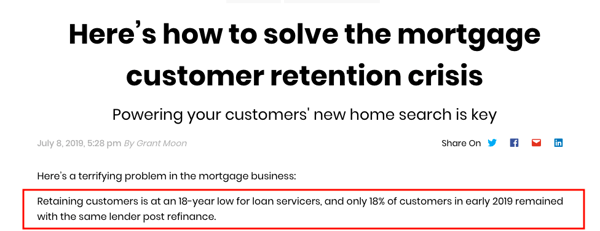 Hard data answer I was looking for
Hard data answer I was looking for
When this happens, it’s really satisfying. Just as important, it provides long-term insight for the topic in question, including how to interpret search results (consumer-facing) to understand how to tweak my query (to yield lender-facing content).
Sometimes, though, the data point that would help you build the perfect argument just isn’t out there. That’s when it’s time for the third strategy.
Third: Asking around your question
If there really is no data available for the point you want to make, it’s time to think of what other data points might help you tell your story.
Say I’m writing about why ecommerce shoe brands should invest in augmented reality but I can’t find any stats about shoe sales and AR. Okay, then what’s another problem ecommerce shoe brands have? High return rates, I’m guessing. So are there stats about how AR can reduce online returns?
You bet there are.

Great results for a second-choice query
As for how to get better at doing those things, I recommend three strategies.
First, spend some time with keyword research. Google Keyword Planner, Neil Patel’s Ubersuggest, Keywords Everywhere, and any other keyword research tool will give you a sense of the slight variations in how people phrase their searches and in what Google considers related queries.
Pay attention, and you’ll have new ideas for how to formulate new versions of your own questions, which may yield better results. You’ll also get better at recognizing queries that are unintentionally confusing (“wedding bands,” for example, might mean rings or musical acts) so you can research more deliberately.
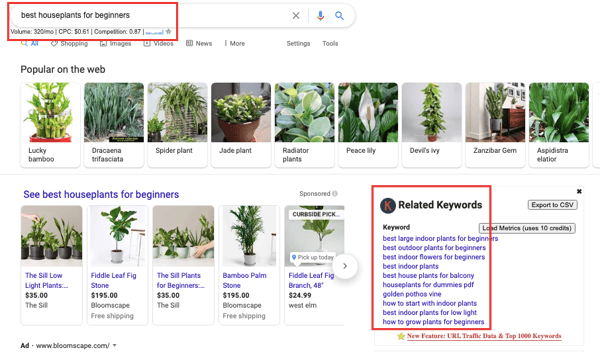
Keyword variations from Keywords Everywhere
The second strategy is to engage in heavy revision. One of my first writing jobs involved writing a lot of “50 states” content, meaning a page of roughly the same content for each of the 50 states (and DC). It was a different time, to be sure.
One thing this incredibly tedious work taught me was how to say the same thing many different ways (because of course they had to be 50 unique versions of the content). Today, the payoff is that I’m good at rephrasing my search queries to increase the odds of finding what I want.
While I don’t recommend anyone spend their time on 50 states content right now, the occasional 20-minute rewrite binge might be useful: set aside 20 minutes every week to rewrite the same sentence or paragraph as many ways as you can. As you do this, you’ll get better at pulling up alternative ways of phrasing things, which will make you better at sleuthing out information you want.
The third strategy is to read SERPs critically.
When you’re on a deadline, it’s easy to scan results pages to see whether they’re going to yield what you want and keep moving if they don’t. But it’s worthwhile to take time to try to understand why you’re seeing the results you’re seeing.
In the mortgage example above, Google’s algorithm was interpreting my queries as if I were a potential mortgage consumer. To get something other than consumer-focused how-to mortgage content, I realized I had to more clearly signal that I was not in the market for a refinance loan.
3: Document What You Find
When you’re doing research for a specific blog post, you’ll no doubt capture the relevant information you find in that document. To make yourself and anyone on your team more efficient in the long term, I recommend having a separate place to document information that you’re likely to use over and over.
At Propllr, we keep what we call a “hot stats” doc for each client, where we…
- Hyperlink our sources.
- Call out the year of their publication.
- List out a few relevant stats from the source that we’ve used and / or that are interesting to what that account covers.
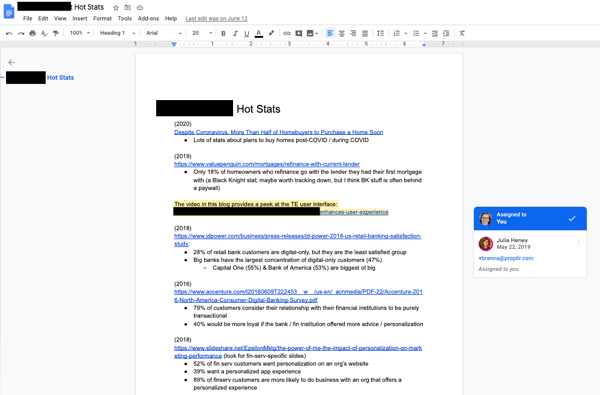
Snippet from a client hot stats doc
We update these docs regularly, as we come across new information. Our friends on the media team sometimes use what we capture there to inform their pitches. These docs are especially helpful for capturing information we come across in our daily lives (while “being curious”) that we would otherwise never be able to track down again.
Another key thing to document during content research is ideas for future content research. One thing that can happen with sleuthing is that you fall down a rabbit hole that eats up hours of your life without yielding any concrete findings for the project you’re working on.
Never fear: with the right documentation, these deep dives can prove useful. As you research, make a note of…
- Compelling reports you might want to investigate later or for another project. Add a note about when and how they may be useful.
- Phrases to search next.
- Alternate and additional arguments you might make, based on the data you’re finding.
- Ideas for future blog posts and content.
With these breadcrumb-type notes, you’ll never come out of a content research session completely empty-handed, even if you don’t get exactly what you want out of it.
Just as important, you’ll likely come across information and inspiration that can support sales teams, bolster investor decks, support other marketing functions, and otherwise help your coworkers do their jobs. Be sure that everyone who can benefit from the information you find has access to it.
4: Follow Quality Standards
So how do you know if the information your content research yields is worthy of being included in a blog post? By setting quality standards. Generally speaking, we follow these rules:
Age: Information should be no more than two years old.
We live in a real-time world, which means we’re used to real-time data.
Of course, conducting, analyzing, and publishing rigorous research takes time. Findings that are two years old or newer are (generally) relevant to what’s happening today.
But there are a lot of exceptions. Certain large-scale studies or government data sets, for example, might only be run every three, five, or 10 years; in that case, it’s best to acknowledge that your numbers are “the most recent available” and to offer any insight you have into how they might be changing.
Another exception: in fast-changing spaces (social media, pandemic research, etc.), two years is an eternity; to be relevant, data must be much newer. Your industry and topics are the best guide for what the “right” age is.
Source: Find the original.
Sometimes this is as easy as clicking a link in a news story to an original research report. Other times, it’s much harder, as when dozens of third parties cite the same statistic but nobody links to the original and when you do track it down, the page has been long removed or the company closed in 2014.
Either case can be valuable:
- When you track down an original report or study, you will inevitably discover more data points that can be useful to your current (and future) projects (and which you can capture in a hot stats doc).
- When you realize there’s no current source for the data you want, you have an opportunity to conduct a study to find that data (and be the place everyone links to!).
Just as you document the data you find, keep a running doc of content ideas or blog ideas where you can capture opportunities like missing data points that many people seem to want. This will make the work of planning your content calendar much easier. (More on that in a part 6.)
Credibility: Make sure the data you’re citing is trustworthy.
A few considerations on this one:
- How many people were surveyed / how many data points were considered?
- Do the people / data constitute a representative sample?
- Who conducted the research? Was it a neutral organization or an industry trade association with a clear investment in the outcome?
- Is the data from your country? Industry? Does it describe your target demographic? If not, is it still applicable?
If the data you’ve found just doesn’t meet your quality standards, you may be better off relying on personal experience. Which deserves its own section.
5: Lean on Experience
Untrustworthy data is worse than no data at all. It feels like a scam to readers who bother to check your sources. So if you can’t find data to meet your quality standards, consider citing the personal experience of whoever has the blog post’s byline. After all, this person should be lending their voice to the topic because they’re deeply familiar with it.
When you do this, specificity boosts credibility.
Good: “In my email marketing experience…”
Better: “In the eight years I’ve been running email tests…”
Better still: “In the eight years I’ve been running B2B and B2C email tests on various platforms…”
6: Identify Information Gaps to Fill
 In content research, data gaps are opportunities!
In content research, data gaps are opportunities!
When you’ve got a blogging deadline to meet, subbing personal experience for a hard data point is a great way to make up for an information gap you aren’t able to fill with research.
As you look at a longer time horizon, though, missing data is an excellent opportunity to conduct original research (via surveys or analysis of owned or publicly available data, for example) to find the answer.
Publishing the data on your website can generate both media attention (depending on the type of data and what you find) and inbound links. We had great success doing this when I was at Insureon by publishing our data on the cost of small business insurance.
As you conduct content research for various projects, you’ll come across these information gaps organically. I’ve seen them take a few forms:
- The oft-cited but impossible-to-track-down stat I mentioned earlier.
- A frequently cited stat that, when you track down its origin, turns out to be extremely out of date (I recently found one lots of industry folks were citing that came from a study conducted in 2007).
- A stat that’s contained in study behind a paywall.
- A stat that almost applies to your audience (e.g., a number for enterprises when you’re writing about small business, or a UK stat when you’re looking at the US).
Finding these opportunities is an exciting part of content research because it means you have a juicy opportunity to add to the knowledge in your field, discover new insights about your audience, and drive a bunch of links to your site.
7: Tweak Your Argument
At Propllr, our content creation process goes like this:
- Brainstorm a topic and summarize it in one to two sentences.
- Outline the full blog post (or other content piece).
- Write.
Typically, our curiosity and some light sleuthing inform the first step. It’s in the second step where we get into serious content research. And sometimes, during that step, we discover that the argument we thought we could build doesn’t actually work, given the data that exists.
Maybe we got a data point from a news story, but the original source reveals that it’s not as applicable to our audience as we thought. Maybe a major event happens between when we brainstormed the topic and when we sat down to outline it.
Whatever the reason, sometimes it’s necessary to tweak our arguments as we go. To understand how to do that, it’s worth reviewing the components of an argument:
- Claim: The thesis or “main point” of an article.
- Reasons: Explanation of the thinking behind the claim.
- Evidence: Data, facts, and other concrete points to support the claim.
If our evidence doesn’t support our claim, we either have to find new evidence or make a new claim. In an ideal world, we’d find new evidence – after all, if we’re making legitimate claims, there should be no shortage of evidence to support them, right?
Yes, in theory. But because we write a lot about new technology and the ways startups are transforming their industries, there isn’t always directly applicable evidence handy.
When we can’t find evidence to support the claim we want to make, we make a different claim that supports the larger argument of the content program we’re working on.
For example:
Early this year, we’d planned a piece that argued that part of the solution for high turnover rates among mortgage originators was better technology – a solid argument. But it also incorporated a lot of data about the tight labor market and how, at a time of historically low unemployment, decreasing turnover was more important than ever and crucial to an organization’s bottom line.
And then the pandemic hit.
Suddenly, our piece was totally irrelevant.
But we knew that the technology we were advocating for still had a lot to offer mortgage lenders. So we scoured the newest industry reports. We found that mortgage lending was still happening, but that it couldn’t happen in physical offices. Bingo.
The same tech that can help with retention can also enable remote origination – and when originators can keep doing their jobs (and earning their commissions) even during a pandemic, they’re more likely to stay with their current employer.
This kind of thing happens all the time. Circumstances change. New data emerges. The content we plan doesn’t always pan out. But when we’re curious and meticulous about research, when we document that research, when we follow quality standards – when we do all that, we’re ready to adapt and adjust so that we’re consistently engaging with what’s happening in the world.
8: Keep the Big Picture in Mind
I promised at the beginning of this piece that I’d offer tips on how to create structurally sound blog posts that convert. So far, and I’ve discussed structure almost exclusively. The conversion part of this puzzle is that all of these structural elements must be in the service of conversion.
These are guidelines for writing excellent blog posts; I stand by that. But I’ll also admit that high-flying blog posts are not what every content program most needs.
For example, some brands may find that “being curious” is the key to their success. By investing time and energy in engaging with industry-relevant social media and becoming a source for information that matters to their target audience, they may be able to convert far more people than by translating that curiosity to blog posts.
Or maybe during the sleuthing process, a brand discovers a major data hole in their industry that they can fill and they invest all their content efforts in creating and updating a data dashboard to fill that gap. And it converts all day long. That’s great.
Another example: We’ve seen success in publishing versions of those “hot stats” pages I mentioned earlier, which can be a great way to drive organic traffic.
The point is, content research doesn’t end with the creation of content. To ensure the content you create is performing to your goals, it’s also essential to examine performance and experiment with ways to improve that performance – which is, I’d argue, also a kind of research.
For Better Content, Do Better Content Research
Content marketing remains wildly popular, and blogging remains a popular component of content marketing. But a lot of blog content on the internet is bad. A lot of it is mediocre. I want to say that this means the good stuff really stands out, but I think it’s subtler than that.
In content marketing (and elsewhere), the medium (in this case, research-backed writing) is like a window: the goal is not for people to look at the window itself but to look at the view beyond. When the writing or the research it’s built on is bad – when the window is dirty or broken or poorly constructed – people notice those problems rather than the message. They don’t internalize the argument or consider its merits.
When the content is good – when the window is functioning properly – the opposite happens. People may not always agree with or be convinced by the arguments the content presents, but they at least consider them. They at least look at the view.
That’s why it’s worthwhile to do the kind of content research that leads to excellent content. Over time, well-structured arguments have a way of taking hold, changing minds, and priming an audience to convert.







